Dunu Vulkan - Unique and Engaging
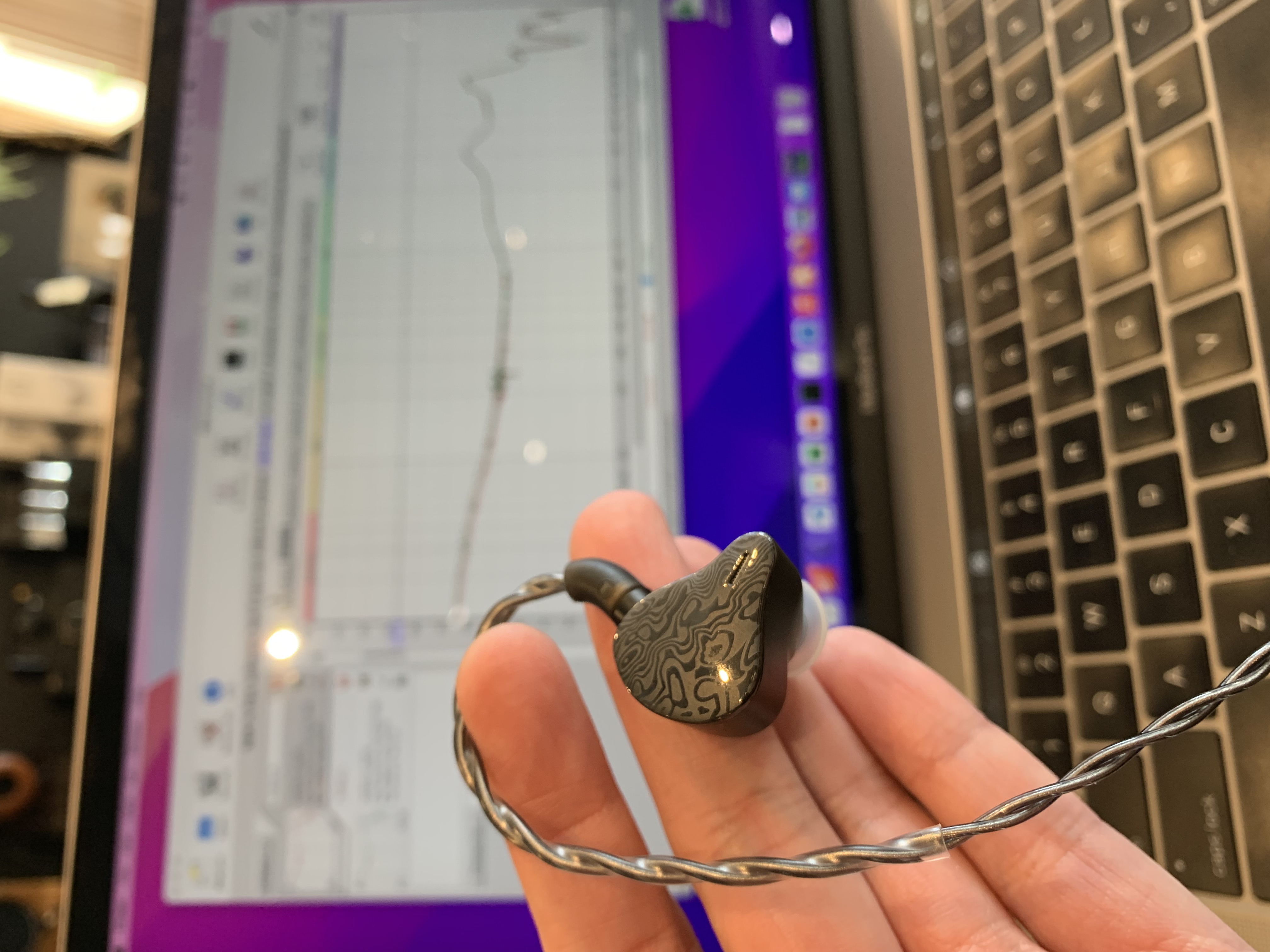
Do you feel Chi-Fi IEMs are evolving to be better yet more similar? Just pick any recent hype train. You would likely find forward upper midrange that more or less follows Harman target, relatively flat or suppressed lower midrange, and sub-bass focused shelf. These tuning choices inevitably lead to a forward, wide, relatively flat soundstage.
On the one hand, this trend is good for average consumers because their likelihood of running into a wonky IEM has reduced substantially. On the other hand, such convergence reduces your chance of running into interesting sound signatures that you didn’t know you liked.
Within this context, let’s discuss Dunu Vulkan, one of the more unusual recent releases in the AUD $550 bracket.
Forewords
- I like highly detailed IEMs that can produce a three-dimensional soundstage illusion and large bass without compromising tonal accuracy too much.
- My music library covers nostalgic pop music, epic orchestral music from Sci-fi shows, classical violin performances, piano, lo-fi beats, and a few rock songs.
- I rate IEMs by A/B tests them against a few benchmark IEMs, regardless of price point. If a $1000 IEM scores the same as a $100 IEM, then either the more expensive one underperforms or the budget one is a gem. See the methodology for more detail.
- I use frequency response measurements to double check my subjective impressions.
- I don’t EQ when testing IEMs. However, I highly recommend EQing to fine-tune good IEMs to your ears and taste.
Non-sound Aspects
Vulkan possesses an interesting driver architecture: 2 dynamic drivers + 4 Knowles BA drivers. The drivers are enclosed in metal shells and face plates that sport engraved patterns. The shells feel rugged yet not very heavy. The nozzles are short and chubby, so your fit greatly depends on your ear tips.
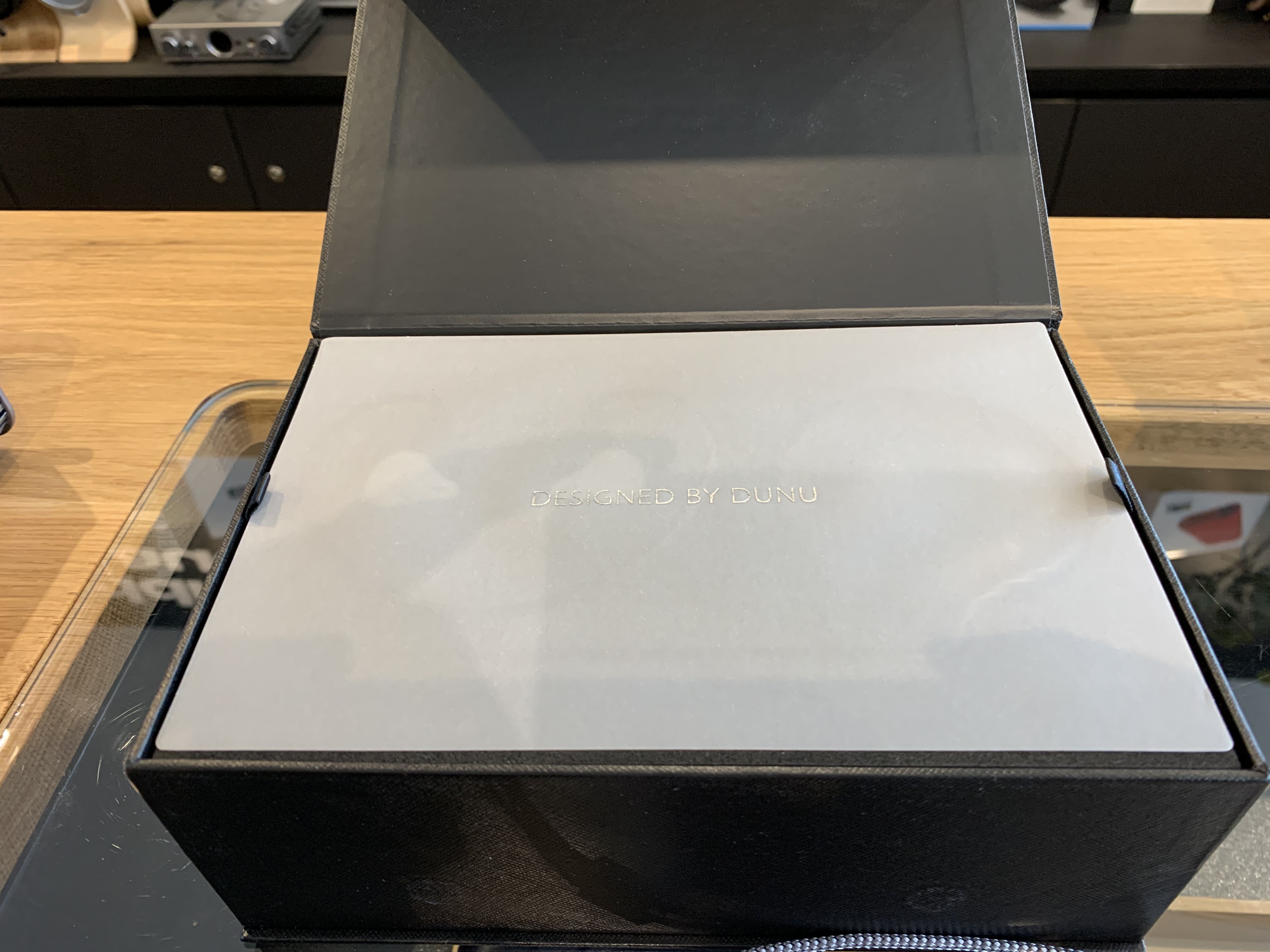

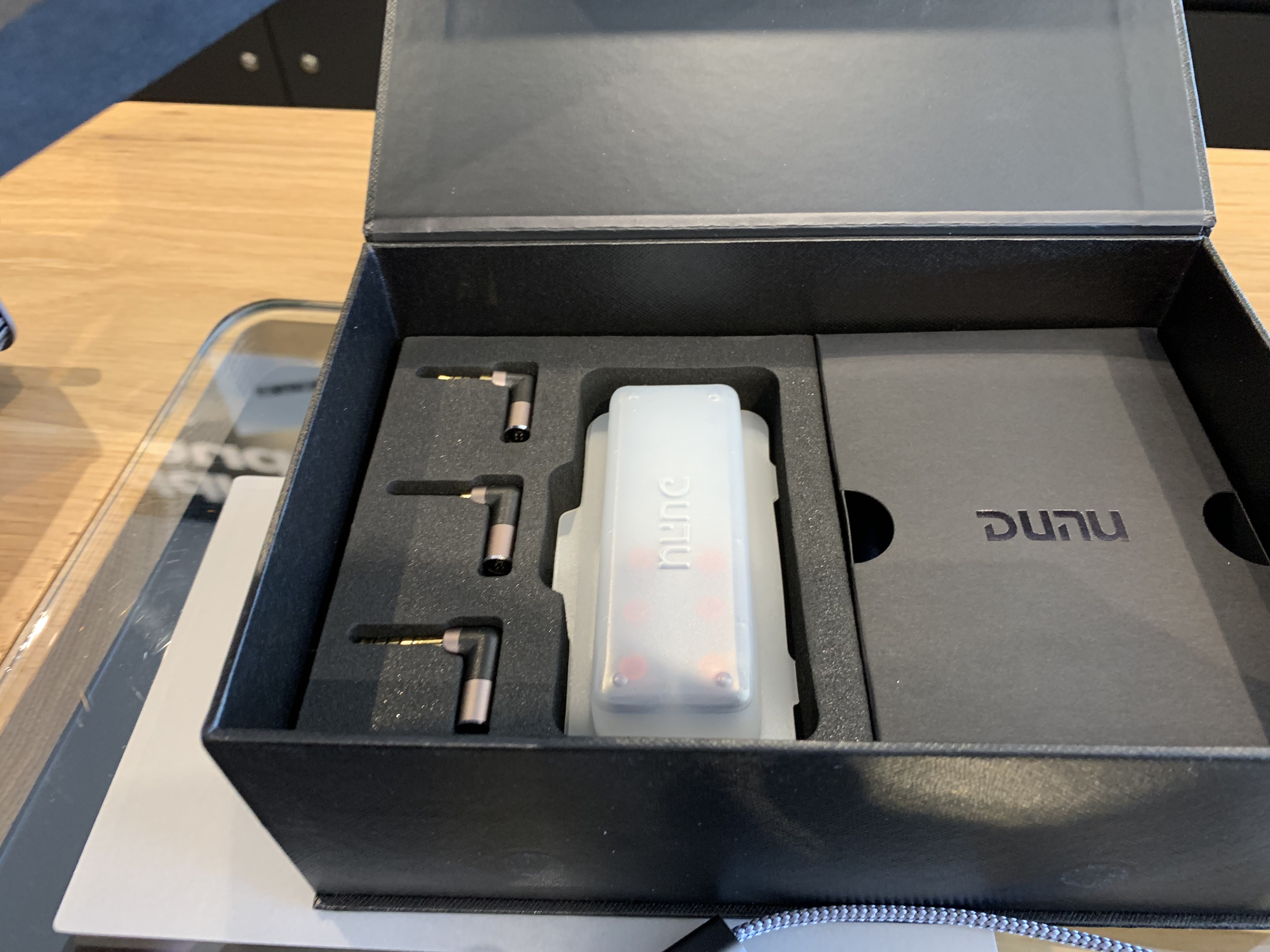
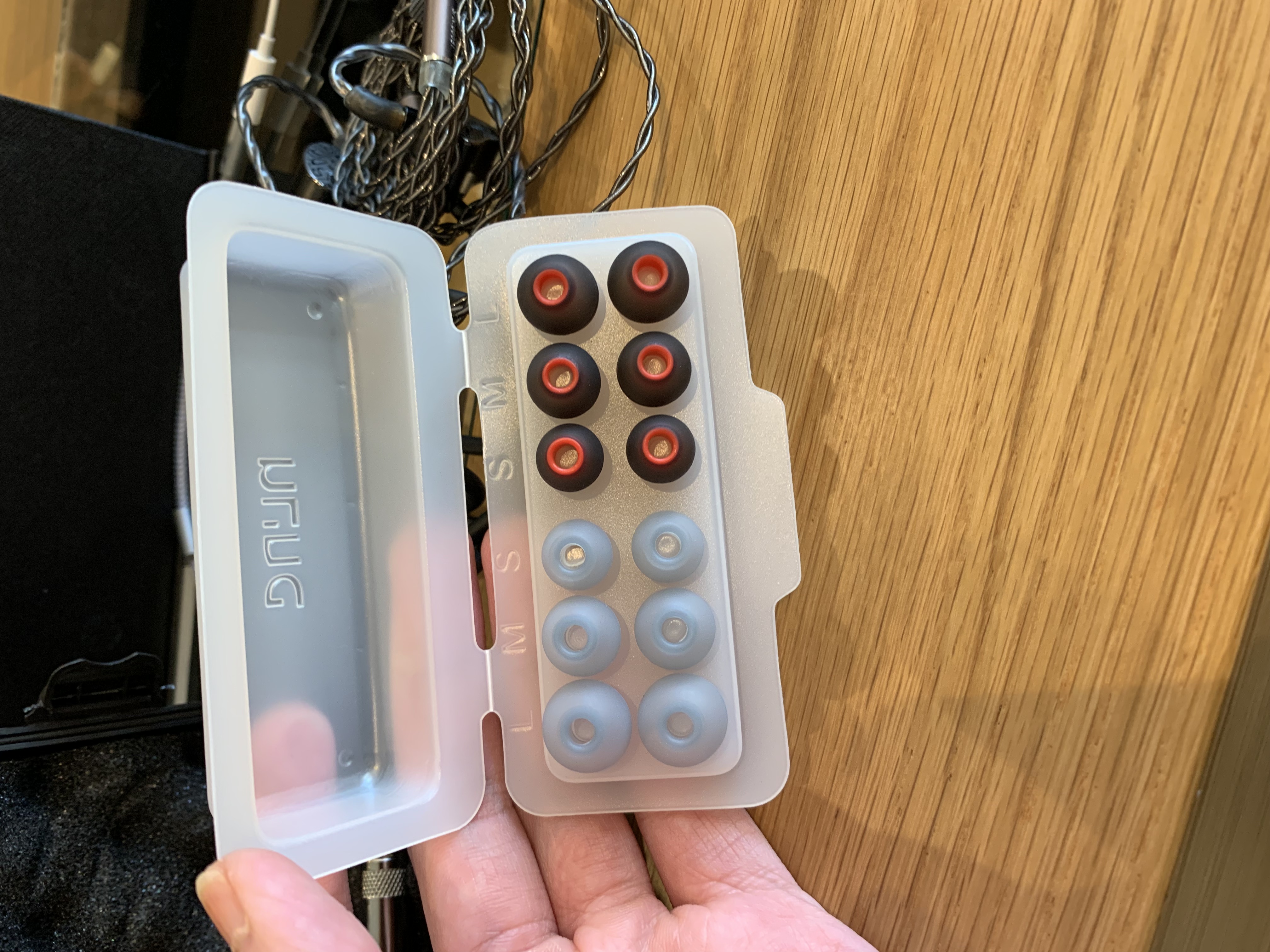
In usual Dunu fashion, Vulkan is accompanied by a generous set of accessories. You have
- 6 pairs of silicone ear tips (the same sets that come with Dunu Titan S)
- 1.2m MMCX cable terminated with the interchangeable plug system of Dunu,
- Carrying case (seems similar to the one that comes with Zen Pro and SA6).
The cable is thick, strong, and well-behaved. It terminates with Dunu’s famous interchangeable plug system featured in their high-end models, not the lite version that comes with Falcon Pro. Vulkan does not feel like a fancy artsy product like the Meze Advar I reviewed recently. Instead, it feels like a decked-out, technology-centric audio product.
Comfort is alright. With my Whizzer tips, Vulkan does not rest against my concha. Instead, it dangles, held by the ear tips and ear hooks. Such fit might create wind noise when you use Vulkan outside. However, there was no comfort issue during my long critical listening session.
Sound Analysis

Frequency response of Vulkan compared to Andromeda 2020 and my preference target. Measurements were done with an IEC-711 compliant coupler and might only be compared with other measurements from this same coupler. The resonance peak was aligned at around 8kHz. Such a peak might be larger on the graph than in real life. Measurements above the resonance peak might not be accurate. Visit my graph database for more comparisons.
If I have to describe Vulkan’s sound with one word, it would be “large”.
The bass tuning of Vulkan is somewhat “old school”, eschewing a distinct bass shelf for an elevation across the lower frequencies. It is not done to the degree of Andromeda or some JH Audio IEMs, but the bass shelf is not as distinct as something like Blessing 2 Dusk or Variations. You might think Vulkan’s bass tuning is “wrong” because the bass “bleeds” all over instead of making distinct and sharp punches. However, I would say this tuning has merit in terms of impact and realism. Kick drums spread across and rumble the entire soundstage. Cellos, contrabasses, and orchestral drums are audible with a strong rumble, lending a realistic and physical sensation to orchestral music.
Vulkan’s upper midrange and lower treble (i.e., the entire ear gain region) are pretty interesting. Vulkan peaks at 3kHz, thus unabashedly pushing the main vocal forward and strictly in-your-head. Therefore, you would think Vulkan is “intimate” if your library is vocal-focused. However, the climb from 1kHz to the peak at 3kHz is much more relaxed. This tuning creates the illusion that some instruments are pushed away from you toward the background. Therefore, Vulkan can have a large soundstage for certain orchestral pieces. Of course, a relaxed upper midrange tuning for enlarging the soundstage is usual. Peaking at 3k to sharpen the vocal as a counterpoint is something I have not heard before. Hats off to Dunu’s engineers for such cleverness.
Treble is where Vulkan tumbles, IMHO. The first problem is the mid-treble region around 6kHz and 8kHz, contributing to both “sparkles” and sibilance in music. Vulkan’s mid-treble is quite forward, to the point of adding an edgy and metallic tine to the timbre of violins, flutes, and even vocals like Ed Sheeran’s. The second problem is the weak upper treble. This region highlights decays, room reverbs, micro-details, and other good bits that create an “audiophile” sound. Lacking upper treble leads to a lack of air and separation between layers of instruments in the soundstage.
Vulkan’s resolution is adequate for its asking price. Note attacks are a bit blunted. Micro-details in the tail-end of notes are very subtle. The lack of upper-treble “air” also reduces the separation between layers of instruments in the soundstage. Vulkan is still better than its competitors in the budget range in terms of resolution. However, it is slightly below other heavy hitters like Blessing 2.
Of course, an enjoyable listening experience requires more than resolution. Let’s listen to some albums, and I will point out the strengths and weaknesses of Vulkan along the way.
Vivaldi: The Four Seasons by Janine Jansen
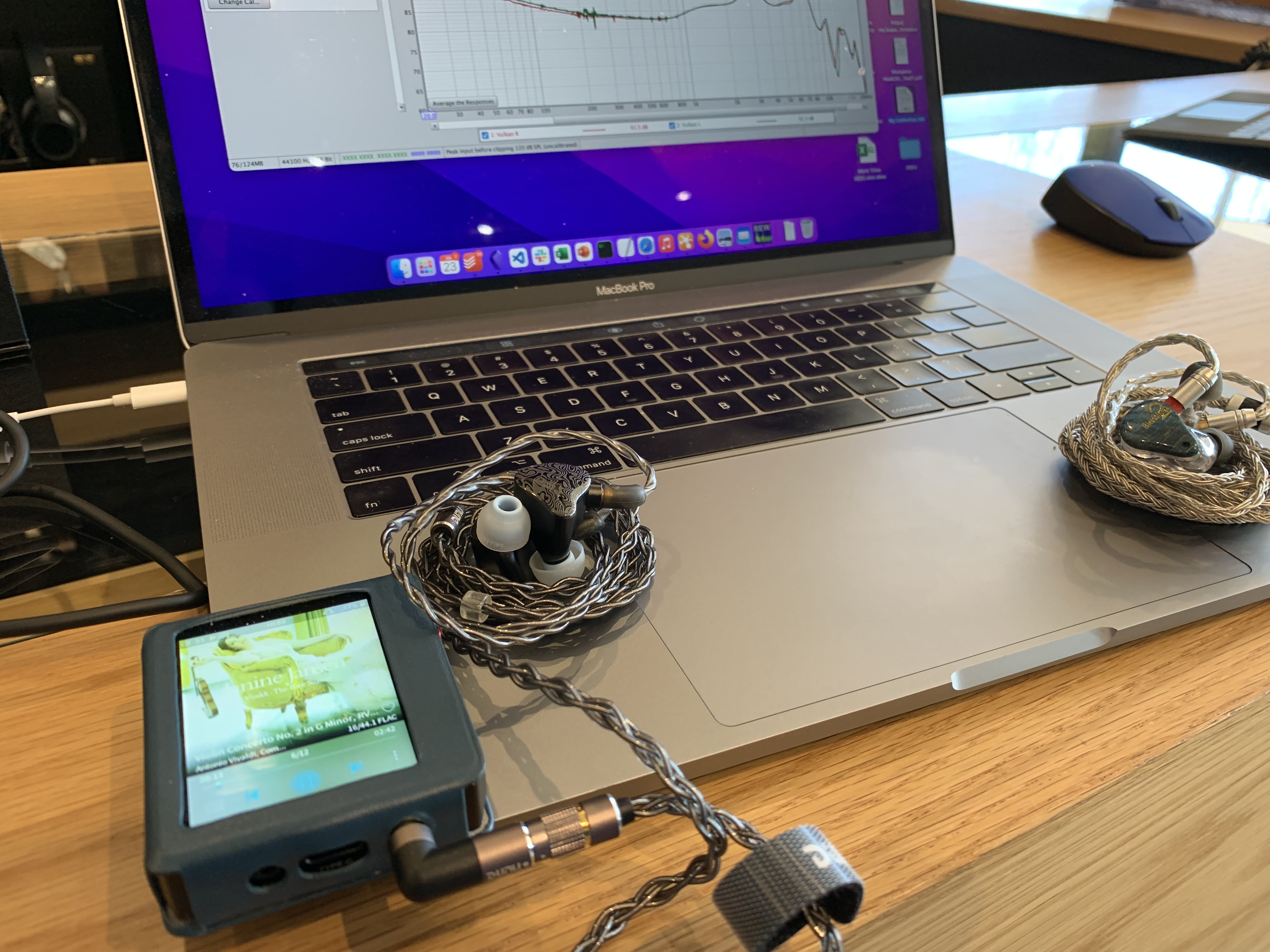
The Four Seasons album was released in 2004 and has been chart-topping ever since. Unlike other recordings of these famous concerti, Janine Jansen plays with a chamber ensemble made up of friends and relatives rather than a big orchestra. The soloist and the ensemble interaction is also a bit different and interesting. For example, there is a back and forth “conversation” between violin and cello at the beginning of the first movement of Autumn.
Vulkan renders the concerti in an interesting way due to its upper midrange tuning. On the one hand, the soundstage is undoubtedly large and decently deep. On the other hand, the soloist is quite in-your-face, more than what I hear from other good soundstage performers like Andromeda. Despite my nitpicking, I find that Vulkan is still successful with these concerti, thanks to its soundstage depth and the rumbly cello that keeps the rhythm.
However, there are two problems. Firstly, I hear a slightly edgy and metallic tone in the violin’s timbre. The timbre is not entirely off but not as natural as I expected. Secondly, Vulkan comes off a bit blunted in busy sections of the concerti. The third movement (Presto) was a challenge for Vulkan. It has difficulty keeping the layers of instruments separated while revealing all the natural nuances of the string instruments. However, this track is one of my library’s “worst-case scenario” tests. The IEM generally holds it together throughout the concerti.
Shall We Dance by Andre Rieu and Johann Strauss Orchestra
Let’s listen to The Second Waltz as an example. This piece sounds similar to some classical CDs back in the 1990s, which place the orchestra in front of rather than around you. Therefore, headphones and IEMs tend to struggle with this piece. For example, my Blessing 2 tends to place the whole orchestra on a flat but wide plane in my head rather than projecting the sound forward.
How does Vulkan sound?
Decently successful. In the first 30 seconds, I can hear the snare near the centre, but a bit further to the background, whilst the cello and bass it near me, just a bit to the right. And then the saxophone comes, located right between the nearer bassline and the snare at the back, slightly to the left of the stage. The woodwind section comes after the saxophone, roughly at the same distance but tilted to the right of the stage. The positioning of instruments from closer to further away is apparent, but the separation between layers is not very strong. When the music swells with the introduction of the string section from 0:45, the stage starts to mesh together. However, the bass is still clear and physical. You can waltz with IEM.
Ed Sheeran Tiny Desk Performance
This performance is excellent for checking the detail retrieval capability of an IEM because you can see the band.
Let’s focus on the Visiting Hours (from 14:15). This song has chime sounds at the beginning and lots of backing vocals. Unfortunately, both chimes and backing vocals are slightly hazy. Of course, this slight haze does not ruin the music or the enjoyment. But it shows that Vulkan lacks that last bit of technical performance to reach the top tier.
The tonality is more troublesome, though. To put it bluntly, Vulkan produces sibilance in this song, which is one of the mildest in his album. Given how sharp Vulkan reproduces Visiting Hours, I did not dare to listen to the whole Shivers (the first song).
Comparisons and Rating
Resolution, Detail, Separation: 3.5/5 - Above Average
Resolution, detail retrieval, or “technical performance” denotes how finely and crisp an IEM or headphone can reproduce audio information. Resolution manifests itself in various aspects: (1) how clear and precise the attack of musical notes are, (2) how pinpoint musical notes are in the soundstage, (3) how detailed and nuanced the decay and reverb of musical notes are, (4) how clear can you hear background elements of a mix, (5) how separated similar sounding instruments are, and (6) can you hear the whole band or orchestra.
Vulkan is adequate. You wouldn’t mistake it for a budget IEM, but I think the jump from a high-performing budget IEM like Titan S to Vulkan is not that big of a leap. If you index resolution heavily in your IEM purchase, then perhaps this IEM is not for you. I rate Vulkan 3.5/5 for resolution, putting it between Aria (3/5 - Average) and Blessing 2 (4/5 - Good).
Percussion Rendering: 4.5/5 - Very Good
Percussion rendering reflects how well the tuning and technical performance of an IEM work together to recreate realistic sound of a drum set. Good drum hits have clear attacks (controlled by frequencies from 4kHz to 6kHz), full body (midbass frequencies around 200Hz), and physical sensation (sub-bass frequencies around 50Hz). Good technical performance (“fast” driver) ensures that bass notes can be loud yet detailed. IEMs that cannot control bass very well tend to reduce the bass’ loudness to prevent muddiness.
Vulkan renders percussion instruments and bass with realism and physical rumble. It’s better than the textureless bass of Blessing 2 (3/5 - Average) and the deep-hitting-but-no-body bass of A4000 (4/5 - Good). However, it cannot challenge the thunderous bass of a properly driven E5000 (5/5 - Outstanding) or Zen Pro. Therefore, I rate Vulkan 4.5/5 for percussion rendering.
Stereo Imaging (Soundstage): 4/5 - Good
Stereo imaging or “soundstage” is a psychoacoustic illusion that different recording elements appear at various locations inside and around your head. Your brain creates based on the cues such as the loudness and phase differences between left and right channels. Most IEMs do not differ significantly, nor can they compete with headphones or loudspeakers. However, some IEMs offer a more spacious soundstage than others. Best IEMs can create multiple layers of sound from closer to further away and make some instruments float slightly above your head.
Vulkan’s soundstage is difficult to rate. It cannot project the centre image (voice, solo instrument) in front of your like other high performers (Andromeda, U6t, U12t, Trio). It also lacks that airy, floating instrument illusion of IEMs with strong upper treble performance. However, Vulkan does have a large soundstage and produces a better illusion of depth than an average Harman-inspired IEMs like Blessing 2 or Aria (3/5 - Average). Therefore, I rate Vulkan 4/5 for soundstage.
Tonality: 3/5 - Average
The tonality of Vulkan is also tricky to rate. The clever and different tuning of Vulkan works most of the time. In my book, unconventional tuning that works deserves a high rating, perhaps even more so than a target hitter. However, Vulkan’s mid-treble peak can be a deal breaker for listeners of harsher genres. Such treble tuning also impacts the timbre of some orchestral instruments negatively. Therefore, I rate Vulkan’s tonality 3/5 - average in the grand scheme.
Conclusion
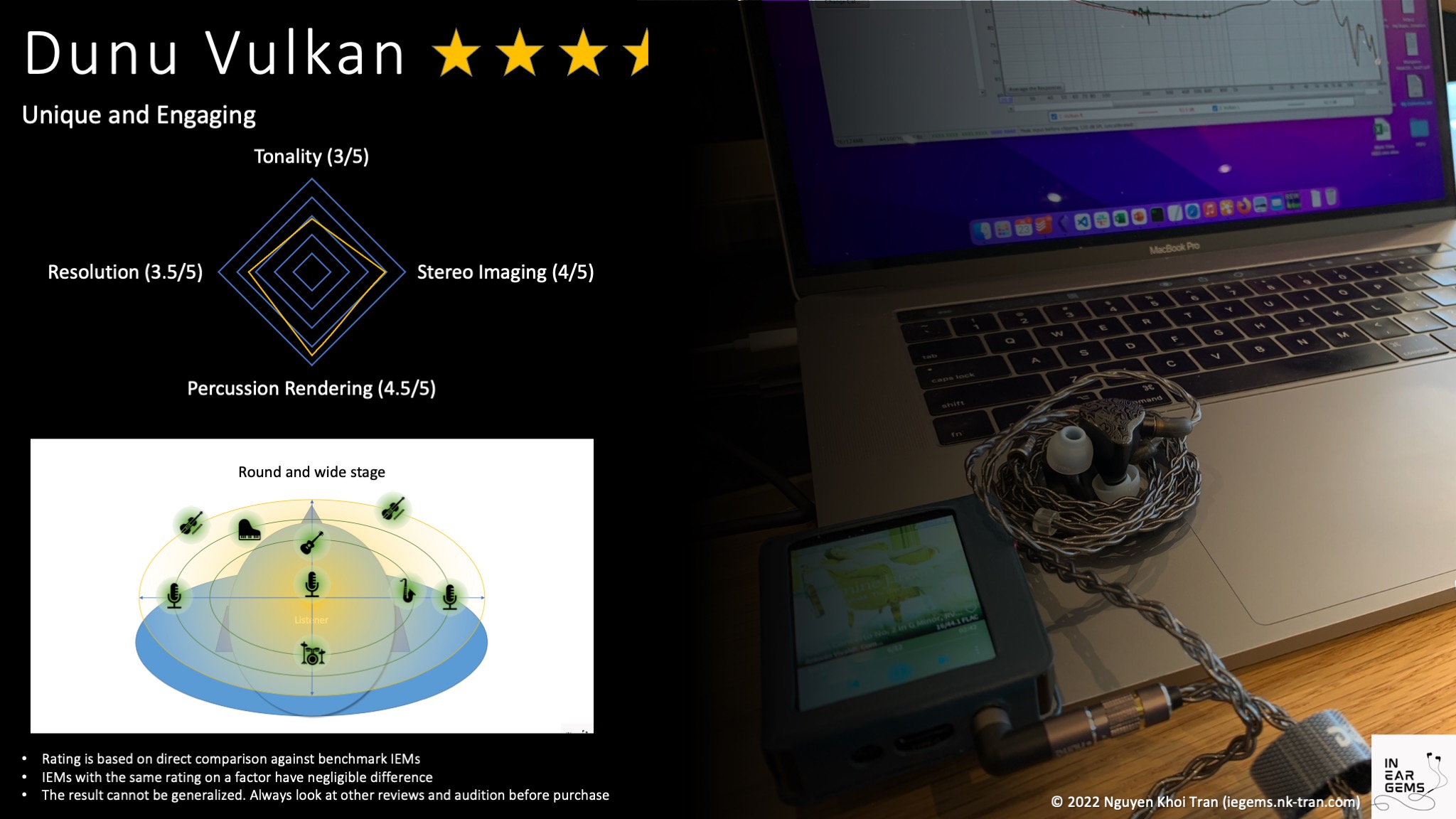
If this review appears to be harsh, it is because I have a high expectation for Vulkan, given its long development, unusual driver topology, and pedigree as a Dunu IEM. Against such expectation, perhaps any IEM would come up short. If you are looking for a highly technical IEM with fun tuning, Vulkan might not be the one.
However, suppose you are looking for an epic-sounding IEM that differs from most new releases. Suppose that you are looking for a well-built IEM with great accessories. Suppose that you are looking for an alternative to Blessing 2. In those cases, Vulkan gets a recommendation from this reviewer.
